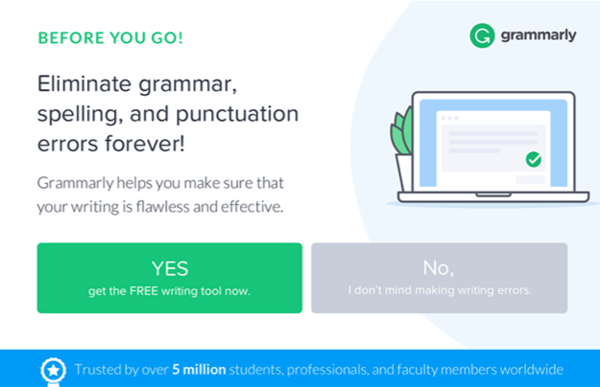You must have heard some cardinal rules for crafting killer call-to-actions (CTAs), like ‘Don’t dilly-dally’, or ‘Be direct with your offer’.
Sound advice, especially when you’re dealing with readers with little time to spare for reading, right?
So you whip out your action words to capture the attention of your audience and hopefully produce more click-throughs. Get limited offer. Download promo code. Start your free trial.
Now structurally, these CTAs seem fine—they’re words strung together inciting your reader to act on your offer. However, ask yourself this: when was the last time you clicked on button or link using the CTAs mentioned above?

Can't remember when was the last time you clicked that CTA?
A week? A month? Don’t remember? That’s okay.
You probably don’t remember because this type of singular-copy CTA has run its course: it’s blasé, it’s predictable. It’s so overused, that it almost becomes invisible. If you choose to restrict yourself to this formula of action verb plus direct object, you’ll only get dismal results.
See, CTAs are not just commands for your readers to obey; they’re opportunities for you to play on emotions! And yes, you’re allowed to use negative emotions! After all, the end goal is to make your readers want to act on an offer presented.
Making the Fear of Missing Out (FOMO) work for your CTAs
 Use FOMO in your CTAs. No one wants to be left behind.
Use FOMO in your CTAs. No one wants to be left behind.
One tactic worth trying when varying your CTAs is one that appeals to fear and frustration. Surely, you’ve heard of FOMO (that’s “Fear Of Missing Out” for those of you who’ve been living under rocks).
CTAs that use FOMO usually work when you’re mentioning a sale or a promotion. You use them to entice your readers to act, right this moment—lest they lose the deal to other buyers.
“Shop until supplies last”, “Try now. Millions already did”, and “Last day to get 30% off” all appeal to urgency. They heighten their readers’ need to win and get the reward before others do.
Play-the-expert CTAs

Play the empathetic professional who knows exactly how to help.
Another way negative CTAs work is by letting your readers feel that they can depend on you for assistance. This is the we-know-what-you’re-going-through strategy. CTAs of this kind feed on your readers’ human need for assurance and certainty.
These CTAs imply that “you’re in the right place; we’re here to give you the solution you need.”
“Sagging profits? Contact us”, “Low conversion rates? We can help”, and “Get your mind off your marketing worries”.
These are effective CTAs because while they emphasise a particular pain point of your readers, they also call attention to your own expertise and willingness to help.
A look at guilt-tripping CTAs
 Confirm-shaming: Have your readers be too ashamed to not click on your CTA
Confirm-shaming: Have your readers be too ashamed to not click on your CTA
How about injecting sarcasm to your CTAs?
While not everyone’s cup of tea, this kind of CTA can potentially set your content apart. And while it may (gasp!) offend or annoy a number of your readers, isn’t this only a good indication of how far you can take your CTA variation test to better study the territory you’re in?
We’re talking about guilt-tripping or confirm-shaming CTAs.
These have your readers second-guessing themselves so that they have no choice but to click on your offer, stat. Again, this goes against the good-ole mantra of marketers to drive conversions using only action words that elicit positive emotion. Then again, it’s a psychological trick that can pay off—especially when done right.
Here are three examples from Grammarly, Esquire, and Harper’s Bazaar that play on this variation:



Grammarly: No, I don't mind making writing errors
Esquire: No thanks, I'll stick to the latest Adam Sandler films.
Bazaar: No thanks, I'm not interested in the 12 Shoes Every Woman Should Own.
A bit cocky for your CTAs, eh? Sure, but these tactics are meant to give a frankly brutal spin to your rather cookie-cutter CTAs. This way, you can see which ticks with your readers and which doesn’t.
Contrary to the claims made online (this and this), such CTAs aren’t simply meant to coerce your readers into action. They exist only to layer the opt-out process, so you can gauge how much off-the-wall humour your audience can take.
Negative CTAs are here to stay
As long as they’re neither predatory nor hurtful, CTAs that appeal to negative emotions can be both amusing and beneficial to your CTR rates. The knowing is in the experimenting, after all. The rule of thumb when creating enticing CTAs? As with any other promotional content, keep learning and relearning the language that produces your ideal response from your audience.

- - -
To learn all about crafting CTAs that convert, check out our free resource: 'ABCTA: The Ultimate Handbook to Call-To-Actions (CTAs)'. Learn the fundamental principles of CTAs, and understand how to deploy them effectively for your business today.

Click the banner above to download our CTA handbook today!